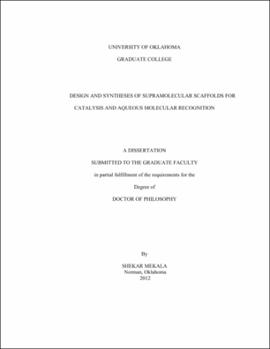| dc.description.abstract | Organic supramolecular systems can be considered as one of the most advanced tools of physical organic chemistry for catalysis. The main aim of the supramolecular model systems for the study of catalytic processes is to explain the observed rate enhancement in terms of reactivity and selectivity of various functional groups. In the last decade, the use of small molecular catalysts become less useful due to their ability in terms of selectivity, reactivity and solubility. Therefore, the use of supramolecular catalysts has become more attractive in the field of organic synthesis and catalysis, especially to perform organic transformations in aqueous media. Since the discovery of picket fence porphyrins by James Collman, the applicability of these molecules in the field of organometallic chemistry and supramolecular chemisty has a high impact in terms of selectivity, reactivity. In this dissertation, we have utilized the Collman's `picket fense' porphyrin concept to design and synthesize meso-tetra(o-alkyl/arylaminphenyl)porphyrins as supramolecualr scaffolds for the dimerization of high molecular weight aldehydes into vicinally functionalized 1,2-diols (pinacols). These vicinal 1,2-diols could also be further derivatized into fuels and value added chemicals. For this process, we have successfully synthesized desired porphyrin scaffolds based on `Dynamic Exchange Reactions' and investigated their thermal stability to design supramolecular catalyst, but failed to utilize these scaffolds for catalyst design due to their low thermal stability. Therefore, for effective, stable and water soluble catalyst design, we have chosen to take the advantage of stable and preorganized calix[4]arene based scaffolding for the non-covalent supramolecular catalyst design to perform the pinacol reactions to dimerize cellulose derived oxygenated feed-stocks such as 5-hydroxymethylfurfurals (HMF), into 1,2-diols in aqueous media. To perform this chemical transformations, initially we have successfully synthesized several water soluble calix[4]arene derivatives and studied the molecular recognition of these calix[4]arenes with various guest molecules in aqueous media for non-covalent catalyst design. Efforts are under way for the water-soluble, non-covalent supramolecular catalyst design for the effective pinacol coupling reactions in aqueous media for biofuel applications. | |
